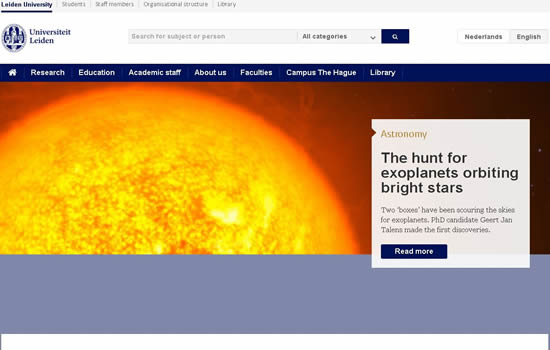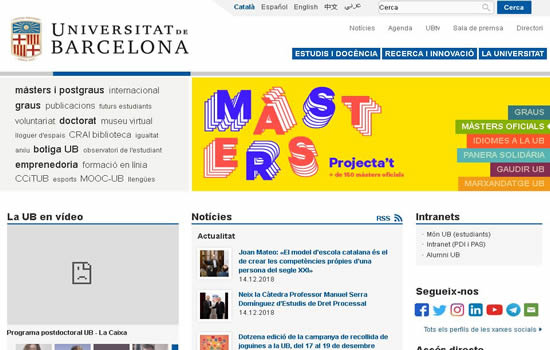选择热点
 荷兰莱顿大学
荷兰莱顿大学 西班牙巴塞罗那大学
西班牙巴塞罗那大学 巴西圣保罗大学 University of Sao Paulo, Brazil
巴西圣保罗大学 University of Sao Paulo, Brazil 台湾南华大学 University of South China in Taiwan
台湾南华大学 University of South China in Taiwan 科技大学 National University of Defense Technology
科技大学 National University of Defense Technology 南京大学 Nanjing University
南京大学 Nanjing University 上海复旦大学 Fudan University
上海复旦大学 Fudan University 泗水大学(Ubaya)
泗水大学(Ubaya) 印尼大学 universitas indonesia
印尼大学 universitas indonesia 越南某大学 Vietnam National University
越南某大学 Vietnam National University 菲律宾大学 University Of The Philippines
菲律宾大学 University Of The Philippines
双语散文:你可以选定一种解释
发布时间:2025-01-06
来源:大学网站
Two trains are traveling side by side and at the same speed along parallel tracks.
We are seated in one of the trains, and with us we have a special speedometer that measures their relative speed.
Since the trains are traveling at the same speed, their relative speed is zero; the speedometer therefore reads "0.
"两列火车以相同的车速并排地沿着两条平行的轨道往前行驰。
我们坐在其中的一列火车上带着特制的速度测量仪,可以测出两列火车之间的相对速度。
因为这两列火车是以相同的车速前进的,所以二者的相对速度是零;因此,测速仪上的读数为0”。
Suddenly the other train seems to start pulling ahead of ours.
The speedometer shows a reading of 10 miles per hour.
The other train has apparently increased its speed.
But can we be absolutely certain of this increase?
突然间另一列火车使我们觉得好像是开始赶到我们所乘坐的火车前头去了。
这时测速仪上显示出来的读数是每小时10英里。
很显然,另一列火车已经加快了速度。
但是,我们能不能肯定是另外那辆火车加快了速度呢?
If your answer is yes, you are wrong.
You are wrong because all that we know is that the relative speed between the two trains changed from 0 mph to 10 mph.
Nothing more.
This change could have been brought about in one of two ways:如果你回答说是的,那你就错了。
你之所以是错了,我们所知道的仅仅是这两辆火车之间的相对速度由每小时0英里增加到了每小时10英里。
仅此而已,这车速的变化很可能是由于下列两种原因中的任何一个原因所造成的:The other train increased its speed.
另一列火车增加了车速。
Our train decreased its speed.
我们的火车降低了车速。
There are thus two possible explanations to account for the change in speed, but we don't know which one is right.
Furthermore, regardless of which explanation we choose, the end result will be the same: the other train will arrive at the station first.
So it makes no difference whether we say that the other train increased its speed or that our train decreased its speed.
因而对于车速的改变就可能有两种不同的解释,但是我们不知道哪一种解释是对的。
进一步来说,不管我们选定了上述两种解释中的哪一种,反正最终的结果是同样的:另一列火车将首先抵达终点站。
所以,不论我们说另一列火车加快了车速,还是说我们所乘的火车减慢了车速,实际上这两种说法没有什么区别。
Since both explanations lead to the same result, you can choose either one.
Whenever two things are relative, you can choose either one of them.
The converse is also true: whenever you have a choice between two things that are equally possible, then the things are relative.
既然上述两种解释会导致同样的结果,那么你选定任何一种解释都可以。
不论任何时候,只要两件事物两种情况是相对的,那你就可以选定其中一种解释。
逆真理亦真,每当你从有同样可能的两件事物中选定其中之一时,那么这两种事物之间就是相对的。
There is no reason, except convenience, for choosing one explanation over the other.
The relative speed between the trains remains the same, 10 mph; and the end result will be the same.
除为了方便这个理由而外,我们选定了一种解释而不选另一种解释根本就没有其他别的原因。
如果两列火车之间的相对速度依然相同,都是每小时10英里,那么最终的结果也会是相同的。
Now let's suppose that both trains are at the railroad station loading and unloading passengers and baggage.
A half-hour passes.
As we look at the other train through our window, we see that our train seems to start moving, smoothly and slowly.
For a minute or so, our train seems to travel at a uniform speed.
Our special speedometer shows that the relative speed between the two trains is 20 mph.
But as we look out our window, we suddenly see the last coach of the other train disappear from sight and notice the motionless station behind it.
So we are not moving after all.
The other train has been moving!
现在我们假设两列火车都在火车站上在上下乘客或装卸行李。
过了半小时以后,当我们透过车窗看另一列火车时,我们看到我们所乘的火车好像是在缓慢地平稳地开始开动了。
约有一分钟左右,我们所乘的火车似乎是在以均匀的速度向前运行。
我们特制的测速仪显示这两列火车的相对速度是每小时20英里。
但当我们往窗外一看,这才突然看见另一列火车的最后一节车厢从我们的视野中正在消失,于是我们看到那一列火车后面留下的是不动的火车站。
所以,我们所乘的火车根本就没有开动。
原来是另外一辆火车在开动!
This peculiar and often frustrating experience is an effect of relative motion.
At the train station we cannot tell whether it was our train that changed its speed from 0 mph to 20 mph or whether it was the other train that changed its speed from 0 mph to 20 mph.
Only after the other train pulled out of the station could we see that it, and not our train, was moving.
这种奇特的而又经常使人沮丧的经历就是相对运动所产生的效应。
在火车站上我们辨别不出是不是我们所乘坐的那一列火车把车速从每小时0英里改变成每小时20英里。
只有当另一列火车驶出火车站之后,这我们才能明白原来是它在开动,而不是我们所乘坐的这列火车在开动。
Now let us again raise the question that was raised at the beginning of this article: can we be absolutely certain that the other train did indeed increase its speed, and in this case pull out of the station?
现在让我们再次提出本文开头所提出过的那个问题:我们能否绝对肯定确实是另一列火车加快了车速,在此情此景驶出了火车站呢?
If your answer is yes, then you are wrong again.
All we can be certain of is that the relative speed between the two trains changed.
如果你回答说是的,那么你就又错了。
我们所能够完全肯定的一点只是这两列火车之间的相对速度变了。
These examples illustrate an important principle in the special theory of relativity.
If A appears to be moving at a steady speed relative to B, we cannot know for sure if it is A that is really moving.
Perhaps A is standing still, and B is moving.
Or perhaps both are moving.
According to relativity, there is no experiment that can be devised to solve the problem.
As there is no way of deciding which of the two objects is moving, we can choose either one as the moving object.
The reason is that their motion is relative, and relativity, as we have seen, means that we have a choice.
这些例子阐明了特殊的相对论中的一个重要的原理。
假如我们觉得A似乎是在用相对于B的一种很均匀的速度在移动,我们就不能肯定地确切知道是否就是A在真的移动。
也许A仍在原地不动而是B在移动。
或者,AB两者都在移动。
根据相对论的说法,根本就不能构想出任何一个实验去解答这个问题。
因为根本没有办法来确定这两个物体中哪一个物体在移动,所以我们可以把两个物体中的任何一个物体认定是在移动着的物体。
理由就是他们的运动是相对的。
正如我们所理解的那样,相对论就意味着我们可以选用一种解释了。
This principle - that if two objects are in uniform motion relative to each other, it is impossible to decide which one is moving and which one is at rest - applies to all objects moving uniformly in a straight line through the universe.
如果两个物体在以相互间相对的同等的运动速度在运动,若想判定哪一个物体在动,哪一个物体原地不动,这是不可能的。
这一原理适用于整个宇宙中凡是作直线等速运动的一切物体。
In relativity you'll find that whenever you have a choice among things that are equally possible, you are dealing with relative things.
For example, time, which is measured with clocks and watches, is relative because it can be shown that there is more than one system of time.
All systems of time are equally possible and you can choose any system you with.
按着相对论的说法你就会发现,每当你在众多同样可能的事物中需要选定一种解释时,你就是在跟相对的事物打交道。
例如,时间,虽然能用钟表加以测量,也是相对的,因为有不止一种时间体系可以来表示时间。
所有的时间体系都同样有可能表示时间,所以你可以选用你所喜欢的时间体系来表示时间。
【双语散文:你可以选定一种解释查看网站:[db:时间]】
We are seated in one of the trains, and with us we have a special speedometer that measures their relative speed.
Since the trains are traveling at the same speed, their relative speed is zero; the speedometer therefore reads "0.
"两列火车以相同的车速并排地沿着两条平行的轨道往前行驰。
我们坐在其中的一列火车上带着特制的速度测量仪,可以测出两列火车之间的相对速度。
因为这两列火车是以相同的车速前进的,所以二者的相对速度是零;因此,测速仪上的读数为0”。
Suddenly the other train seems to start pulling ahead of ours.
The speedometer shows a reading of 10 miles per hour.
The other train has apparently increased its speed.
But can we be absolutely certain of this increase?
突然间另一列火车使我们觉得好像是开始赶到我们所乘坐的火车前头去了。
这时测速仪上显示出来的读数是每小时10英里。
很显然,另一列火车已经加快了速度。
但是,我们能不能肯定是另外那辆火车加快了速度呢?
If your answer is yes, you are wrong.
You are wrong because all that we know is that the relative speed between the two trains changed from 0 mph to 10 mph.
Nothing more.
This change could have been brought about in one of two ways:如果你回答说是的,那你就错了。
你之所以是错了,我们所知道的仅仅是这两辆火车之间的相对速度由每小时0英里增加到了每小时10英里。
仅此而已,这车速的变化很可能是由于下列两种原因中的任何一个原因所造成的:The other train increased its speed.
另一列火车增加了车速。
Our train decreased its speed.
我们的火车降低了车速。
There are thus two possible explanations to account for the change in speed, but we don't know which one is right.
Furthermore, regardless of which explanation we choose, the end result will be the same: the other train will arrive at the station first.
So it makes no difference whether we say that the other train increased its speed or that our train decreased its speed.
因而对于车速的改变就可能有两种不同的解释,但是我们不知道哪一种解释是对的。
进一步来说,不管我们选定了上述两种解释中的哪一种,反正最终的结果是同样的:另一列火车将首先抵达终点站。
所以,不论我们说另一列火车加快了车速,还是说我们所乘的火车减慢了车速,实际上这两种说法没有什么区别。
Since both explanations lead to the same result, you can choose either one.
Whenever two things are relative, you can choose either one of them.
The converse is also true: whenever you have a choice between two things that are equally possible, then the things are relative.
既然上述两种解释会导致同样的结果,那么你选定任何一种解释都可以。
不论任何时候,只要两件事物两种情况是相对的,那你就可以选定其中一种解释。
逆真理亦真,每当你从有同样可能的两件事物中选定其中之一时,那么这两种事物之间就是相对的。
There is no reason, except convenience, for choosing one explanation over the other.
The relative speed between the trains remains the same, 10 mph; and the end result will be the same.
除为了方便这个理由而外,我们选定了一种解释而不选另一种解释根本就没有其他别的原因。
如果两列火车之间的相对速度依然相同,都是每小时10英里,那么最终的结果也会是相同的。
Now let's suppose that both trains are at the railroad station loading and unloading passengers and baggage.
A half-hour passes.
As we look at the other train through our window, we see that our train seems to start moving, smoothly and slowly.
For a minute or so, our train seems to travel at a uniform speed.
Our special speedometer shows that the relative speed between the two trains is 20 mph.
But as we look out our window, we suddenly see the last coach of the other train disappear from sight and notice the motionless station behind it.
So we are not moving after all.
The other train has been moving!
现在我们假设两列火车都在火车站上在上下乘客或装卸行李。
过了半小时以后,当我们透过车窗看另一列火车时,我们看到我们所乘的火车好像是在缓慢地平稳地开始开动了。
约有一分钟左右,我们所乘的火车似乎是在以均匀的速度向前运行。
我们特制的测速仪显示这两列火车的相对速度是每小时20英里。
但当我们往窗外一看,这才突然看见另一列火车的最后一节车厢从我们的视野中正在消失,于是我们看到那一列火车后面留下的是不动的火车站。
所以,我们所乘的火车根本就没有开动。
原来是另外一辆火车在开动!
This peculiar and often frustrating experience is an effect of relative motion.
At the train station we cannot tell whether it was our train that changed its speed from 0 mph to 20 mph or whether it was the other train that changed its speed from 0 mph to 20 mph.
Only after the other train pulled out of the station could we see that it, and not our train, was moving.
这种奇特的而又经常使人沮丧的经历就是相对运动所产生的效应。
在火车站上我们辨别不出是不是我们所乘坐的那一列火车把车速从每小时0英里改变成每小时20英里。
只有当另一列火车驶出火车站之后,这我们才能明白原来是它在开动,而不是我们所乘坐的这列火车在开动。
Now let us again raise the question that was raised at the beginning of this article: can we be absolutely certain that the other train did indeed increase its speed, and in this case pull out of the station?
现在让我们再次提出本文开头所提出过的那个问题:我们能否绝对肯定确实是另一列火车加快了车速,在此情此景驶出了火车站呢?
If your answer is yes, then you are wrong again.
All we can be certain of is that the relative speed between the two trains changed.
如果你回答说是的,那么你就又错了。
我们所能够完全肯定的一点只是这两列火车之间的相对速度变了。
These examples illustrate an important principle in the special theory of relativity.
If A appears to be moving at a steady speed relative to B, we cannot know for sure if it is A that is really moving.
Perhaps A is standing still, and B is moving.
Or perhaps both are moving.
According to relativity, there is no experiment that can be devised to solve the problem.
As there is no way of deciding which of the two objects is moving, we can choose either one as the moving object.
The reason is that their motion is relative, and relativity, as we have seen, means that we have a choice.
这些例子阐明了特殊的相对论中的一个重要的原理。
假如我们觉得A似乎是在用相对于B的一种很均匀的速度在移动,我们就不能肯定地确切知道是否就是A在真的移动。
也许A仍在原地不动而是B在移动。
或者,AB两者都在移动。
根据相对论的说法,根本就不能构想出任何一个实验去解答这个问题。
因为根本没有办法来确定这两个物体中哪一个物体在移动,所以我们可以把两个物体中的任何一个物体认定是在移动着的物体。
理由就是他们的运动是相对的。
正如我们所理解的那样,相对论就意味着我们可以选用一种解释了。
This principle - that if two objects are in uniform motion relative to each other, it is impossible to decide which one is moving and which one is at rest - applies to all objects moving uniformly in a straight line through the universe.
如果两个物体在以相互间相对的同等的运动速度在运动,若想判定哪一个物体在动,哪一个物体原地不动,这是不可能的。
这一原理适用于整个宇宙中凡是作直线等速运动的一切物体。
In relativity you'll find that whenever you have a choice among things that are equally possible, you are dealing with relative things.
For example, time, which is measured with clocks and watches, is relative because it can be shown that there is more than one system of time.
All systems of time are equally possible and you can choose any system you with.
按着相对论的说法你就会发现,每当你在众多同样可能的事物中需要选定一种解释时,你就是在跟相对的事物打交道。
例如,时间,虽然能用钟表加以测量,也是相对的,因为有不止一种时间体系可以来表示时间。
所有的时间体系都同样有可能表示时间,所以你可以选用你所喜欢的时间体系来表示时间。
【双语散文:你可以选定一种解释查看网站:[db:时间]】
- 上一篇: 双语美文:生命的度量
- 下一篇: 双语美文:幸福从内心滋生
相关阅读
目录列表
资讯列表
英语资讯


共0条评论
网友评论温馨提示:您的评论需要经过审核才能显示,请文明发言!